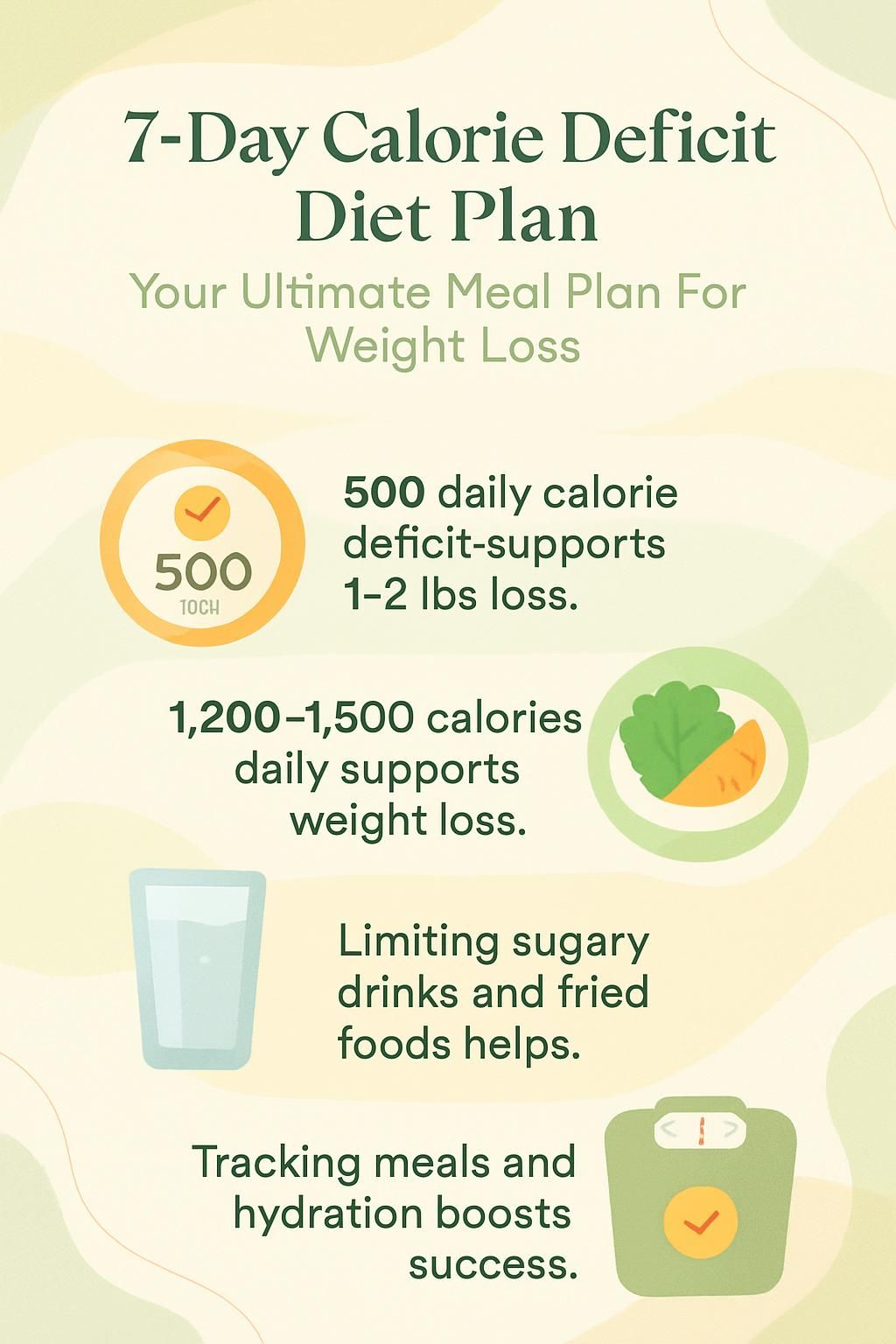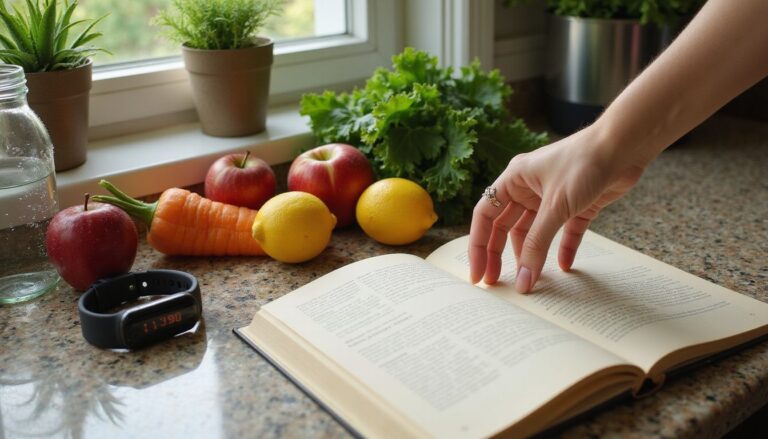7-Day Calorie Deficit Diet Plan: Your Ultimate Meal Plan For Weight Loss
Our Nutrition Assistant AI Suite will transform your body. You will lose fat, get toned, and build muscle. Gain confidence and optimal health.
If you want to lose weight but feel unsure about what or how much to eat, you are not alone. A simple calorie deficit, which means eating fewer calories than you burn, can help you lose 1 to 2 pounds per week in a safe way.
This guide gives you a clear 7-day meal plan that uses everyday foods like lean protein, spinach, yogurt, brown rice, and sweet potato. You will also get step-by-step tips to set your daily calorie goal and stick to it without feeling stressed.
You can start today with small changes. When healthy choices fit your routine, progress feels much easier.
Key Takeaways
- A daily calorie deficit of about 500 calories can support 1 to 2 pounds of weight loss per week, as noted in the Dietary Guidelines for Americans 2020 to 2025.
- Use the Mifflin St. Jeor equation to estimate your basal metabolic rate, then apply an activity multiplier to find your Total Daily Energy Expenditure, or TDEE.
- Focus on whole foods, such as lean protein, fruits, vegetables, and whole grains, and aim for roughly 1,200 to 1,500 calories per day if appropriate for your needs.
- Limit sugary drinks, fried foods, and highly processed snacks since they raise calorie intake quickly and can slow healthy weight loss.
- Tracking meals, drinking enough water, and staying active increase the odds of maintaining a steady calorie deficit each week.

Understanding Calorie Deficit for Weight Loss

Knowing how a calorie deficit works makes weight loss simpler. I walk you through setting a realistic daily calorie goal and building a diet meal plan that fits your life.
How Do You Calculate Your Total Daily Energy Expenditure (TDEE)?
I start with my basal metabolic rate, or BMR. BMR is the energy my body uses at rest. The Mifflin St. Jeor equation estimates BMR using weight, height, age, and sex. For men, the calculation ends by adding 5. For women, it ends by subtracting 161. Many dietitians use this method because research supports its accuracy.
To turn BMR into TDEE, I apply an activity multiplier: sedentary x1.2, lightly active x1.375, moderately active x1.55, very active x1.725, or extra active x1.9. This factor reflects daily movement, not just formal exercise.
Online tools, including the MyPlate Plan Calculator, use evidence-based formulas from the USDA and Health and Human Services. I find these calculators helpful, especially for meal prep. They give me a target that matches my routine so I am not guessing how many calories per day I need.
How Do You Set a Target Calorie Deficit?
After I know my TDEE, I subtract about 500 calories to aim for a steady loss of about 1 to 2 pounds per week. If my TDEE is 2,000, I start near 1,500 calories per day. This controlled approach lowers health risks compared with crash diets.
Personal factors matter, such as age, sex, body weight, activity level, and health conditions. Very low intakes can lead to hunger and low energy. If I feel sluggish, I add volume with fruit, vegetables, or a little extra lean protein to stay satisfied while keeping a deficit.
If you have medical issues, a registered dietitian or healthcare provider can help you adjust your plan. Safer changes lead to lasting results.
Strategies for Achieving Calorie Deficit
Small daily habits add up fast. I use easy diet and activity strategies that fit a normal schedule.
How Can You Reduce Your Caloric Intake?
Cutting calories does not have to feel harsh. These steps keep me full while staying within my daily calorie goal.
- I replace soda, energy drinks, and sweetened coffee with water or unsweetened tea, saving up to 300 calories per drink.
- I shrink portions by using smaller plates, which helps me eat less without feeling deprived.
- I choose whole foods, like vegetables, lean protein, low-fat Greek yogurt, and whole grains, instead of packaged or frozen meals.
- I swap high-calorie snacks for fruit, raw veggies with salsa, or a small bowl of cottage cheese to increase dietary fiber and protein.
- I bake, steam, or grill instead of frying to reduce fat and total calories.
- I log meals in a calorie tracking app so I see the true impact of snacks and desserts.
- I am careful with “diet” snacks. Some leave me hungry, which can lead to overeating later.
These changes helped me lose weight while still enjoying balanced meals. Pairing them with more movement makes results more consistent.
What Are Effective Ways to Boost Physical Activity?
More movement raises your TDEE. I focus on options that fit my week and protect my joints.
- I start with 30 minute walks three times a week to lift my heart rate and support fat loss.
- I swim once or twice weekly since it burns calories and is easy on my knees and hips.
- I bike or hike outdoors to make exercise feel enjoyable and to increase daily energy expenditure.
- I jog on weekends to build stamina and heart health.
- I lift light weights two days a week to maintain muscle while dieting.
- I add extra steps, take the stairs, do yardwork, or walk to lunch for simple daily movement.
- I track progress with body measurements of the waist, hips, and arms, not just the scale.
- I join group workouts with friends to boost accountability and keep it social.
- I add short activity breaks during the day to keep metabolism steady.
- I try classes like swimming or cycling for coaching and support.
These habits help me stick to low-calorie goals, feel satisfied after meals, and keep weight off long term.
Recommended Foods in a Calorie Deficit Diet
Picking the right foods makes a calorie deficit easier. I look for meals that keep me full, support muscle, and deliver key nutrients.
Why Focus on Lean Proteins?
Lean proteins, such as chicken, turkey, white fish, salmon, tofu, and tempeh, help me feel full longer. Higher protein intakes improve appetite control and protect muscle while I lose fat.
Eggs at breakfast or lunch add satiety and support recovery from exercise. On busy days, I use plain strained yogurt or kefir for dairy protein. If I need a plant-based boost, I may use a simple pea or soy protein powder.
Placing protein on every plate helps stabilize blood sugar and slows digestion. That makes sticking to my daily calorie target much easier.
What Are the Benefits of Whole Grains?
Oats, brown rice, farro, quinoa, bulgur, barley, and millet give me fiber, minerals, and lasting energy. Whole grains help me stay full, which supports a steady calorie deficit.
Compared with refined options like white bread or sugary cereal, whole grains offer more nutrients per bite. I often choose quinoa or oats to keep energy even through the afternoon.
A simple switch like a baked potato with salsa instead of butter can reduce calories while staying satisfying. Grain salads with vegetables keep me fueled on busy days.
How Do Fruits and Vegetables Support Weight Loss?
Fruits and vegetables add volume with fewer calories. Non-starchy choices like leafy greens, peppers, mushrooms, tomatoes, cauliflower, and broccoli let me fill half my plate without overshooting my goal.
High-fiber fruit, such as berries, apples, pears, and melon, helps me stay full and supports digestion. Research links higher fruit and vegetable intake to better weight control and lower disease risk.
Starchy vegetables, like potatoes and sweet potatoes, provide steady energy when eaten in smart portions. They fit well in a reduced-calorie plan.
Why Choose Healthy Fats?
Healthy fats help me absorb vitamins and stay satisfied. I use avocados, olive oil, and small portions of coconut or avocado oil in my cooking.
Nuts, seeds, and natural nut butters add crunch, flavor, and satiety. Unsweetened plant milks, like soy or coconut milk, work well for smoothies and coffee.
Moderate fat intake supports heart health and keeps meals satisfying. Pairing these fats with vegetables and protein builds balanced plates.
Foods to Limit for Effective Weight Loss
Some foods pack in calories fast. Cutting back on these helps me hit my goal sooner without feeling restricted.
What Sugary Snacks and Beverages Should You Avoid?
Sweet drinks and desserts raise calorie intake with very little nutrition. These swaps make a big difference.
- I avoid candy, cakes, pastries, and sugary snack bars since they add a lot of calories for very little fullness.
- I skip soda, fruit juice, energy drinks, flavored milk, and sweet coffee drinks. Water or no-calorie drinks are better for hydration.
- I watch for hidden sugars in cookies, packaged pies, and sweet breakfast cereals.
- I limit sweet sauces, like barbecue sauce and flavored syrups, since they can add more sugar than I expect.
- I avoid pairing fried snacks with sugary dips, which doubles the calories.
- High sugar intake is linked to obesity and disease risk, so cutting back supports healthy weight.
- Frequent sugar spikes lead to more cravings later. Occasional treats are fine, but I plan them.
- I make my own smoothies to control ingredients instead of buying pre-sweetened blends.
Why Cut Back on Processed Foods?
Many processed foods contain excess sugar, unhealthy fats, and sodium. These ingredients make me hungrier and can disrupt digestion.
Common examples include fast food burgers, frozen pizzas, diet bars, and some packaged snacks. They are often less filling than whole foods like vegetables, beans, and whole grains.
Frequent intake of ultra-processed meals is linked with higher disease risk in national dietary guidance. I feel better when I base my meals on whole, nutrient-dense options.
How Does Reducing Fried Foods Help Weight Loss?
Fried foods like chips, breaded chicken, and doughnuts add many calories and unhealthy fats. A serving of French fries can have about double the calories of a similar amount of baked potato.
Choosing baked, grilled, or air-fried options saves calories and lowers inflammation. I noticed steadier energy once I swapped fried choices for grilled chicken and roasted vegetables.
These small changes kept me full, reduced empty calories, and moved the scale in the right direction.
Advantages of a Calorie Deficit Diet
A calorie deficit diet can be filling and flexible. It supports fat loss while protecting your health.
How Does a Calorie Deficit Lead to Sustainable Weight Loss?
A steady calorie deficit helps me lose about 1 to 2 pounds per week. My body uses stored fat for energy when food intake is lower than my needs.
Meals rich in protein and fiber control hunger, which reduces snacking. Whole foods make it easier to avoid overeating and weight regain later.
Tracking calories and setting realistic goals make the plan easier to follow.
Can a Calorie Deficit Enhance Energy Levels?
Balanced meals help me feel steady energy even in a deficit. I combine lean proteins, healthy fats, and complex carbs to keep blood sugar stable.
I avoid sugary snacks and sweetened drinks that cause energy spikes and crashes. Drinking water throughout the day helps me stay alert and reduces “false hunger.”
Regular exercise improves my mood and energy. Skipping heavy fried foods prevents sluggish afternoons.
How Does This Diet Promote Better Health?
Eating mostly whole foods reduces disease risk over time. Lean protein, vegetables, fruit, and fiber support heart health, blood sugar control, and digestion.
I also sleep better and move more easily when I fuel well and stay active. Measuring progress with both weight and tape measurements shows real changes in body composition.
If you have health concerns or take medication, talk with a healthcare provider before making big changes. A balanced plan keeps nutrition on track while you lose weight.
Detailed 7-Day Calorie Deficit Meal Plan
A structured plan removes guesswork and helps maintain a calorie deficit. I focus on simple meals, practical portions, and repeatable habits. Talk to your doctor before starting any new diet, especially if you have health conditions.
What Balanced Meal Options Are Suggested for Day 1?
Breakfast: Greek yogurt with a half cup of mixed berries. It delivers protein, fiber, and antioxidants for a strong start.
Lunch: A large spinach salad with grilled chicken, strawberries, tomatoes, cucumbers, and a tablespoon of feta. Bright flavors and lean protein keep me full.
Dinner: Baked salmon with sautéed onions and zucchini. Salmon adds healthy fats without too many calories.
Snacks: Cucumber slices, ten baby carrots, an apple, a low-fat string cheese, two tablespoons hummus, or eight almonds. These help me stay near 1,500 calories for the day.
What Healthy Snacks and Choices Are Included on Day 2?
Breakfast: Whole grain toast with a thin smear of nut butter and sliced banana for fiber and steady energy.
Lunch: Hearty vegetable soup, about 250 calories per serving. It is warm, filling, and easy to make ahead.
Dinner: Stir-fried chicken with mixed vegetables and a small portion of brown rice for balance.
Snacks: A tablespoon of chia seeds mixed into yogurt and a small handful of pumpkin seeds. I keep snacks around 100 to 150 calories each.
Which Protein-Rich Foods Help with Satiety on Day 3?
Breakfast: A parfait with Greek yogurt, berries, and seeds. It supplies more than 15 grams of protein and helpful fiber.
Lunch: Lean pork chop with a side of roasted vegetables. A 3 ounce cooked portion has about 22 grams of protein.
Dinner: Grilled chicken breast with chipotle chili powder salsa and a side of sautéed peppers. About 26 grams of protein per serving supports fullness.
Snack: Simple egg salad made with two eggs for about 12 grams of high-quality protein. These choices reduce cravings between meals.
What Nutrient-Dense Meals Are Recommended for Day 4?
Breakfast: Scrambled eggs with spinach and tomatoes on whole grain toast. Protein, iron, and vitamin C support energy and recovery.
Lunch: Grilled chicken over quinoa with roasted broccoli and carrots. This mix brings fiber, protein, and micronutrients.
Snack: Greek yogurt with fresh blueberries for probiotics and antioxidants.
Dinner: Baked salmon with brown rice, steamed asparagus, and a side salad with olive oil dressing. I stay near 1,500 calories by keeping portions modest.
How to Balance Macronutrients on Day 5?
Breakfast: Rolled oats topped with almonds and blueberries. Carbs, healthy fats, and some protein keep me satisfied.
Lunch: Grilled chicken breast with quinoa and steamed broccoli. Lean protein and whole grains support stable energy.
Dinner: Lentil soup and a small slice of whole grain avocado toast. Plant protein plus fiber helps me feel full.
Snacks: Greek yogurt with chia seeds or sliced apple with natural peanut butter. Portion control prevents unwanted calorie creep.
Why Prioritize Hydration and Light Meals on Day 6?
Hydration supports digestion, mood, and energy. I choose water, sparkling water, black coffee, and green tea.
Meals stay light with extra vegetables, fruit as snacks, lean chicken or fish, and small servings of brown rice or quinoa. During one spring week, I noticed that drinking enough water made hunger easier to manage between meals.
High-water foods, like cucumber and watermelon, help me feel satisfied with fewer calories.
What Light Calorie Meals Wrap Up Day 7?
Breakfast: Egg white omelet with spinach and mushrooms, plus sliced tomatoes.
Lunch: Grilled chicken with steamed broccoli and quinoa for steady fuel.
Snack: Crisp cucumber salad with lemon juice to stay light on calories.
Dinner: Baked white fish with roasted asparagus and carrots. If I need a snack later, I choose bell pepper strips or celery sticks. I keep beverages to water, unsweetened herbal tea, or black coffee.
What Are Some Daily Meal Examples?
Simple templates help me stay consistent. These examples fit a calorie deficit diet and are easy to repeat.
What Is a Healthy Breakfast Example?
Greek yogurt layered with berries and a sprinkle of rolled oats, about 500 calories when portions are measured. The combo supplies protein, antioxidants, and fiber for lasting fullness.
Another option is whole grain toast topped with sliced banana or apple. Whole grains give complex carbs, while fruit adds vitamins and natural sweetness without added sugar.
What Makes a Balanced Lunch?
Salads with chicken, fish, or tofu plus colorful vegetables are filling and fast. I add quinoa or brown rice for steady energy and include avocado or a drizzle of olive oil for healthy fats.
I keep lunches near 500 calories by watching dressings and skipping processed meats. Chopped vegetables add fiber and help control hunger through the afternoon.
What Is a Nutritious Dinner Option?
Salmon, chicken breast, or lean pork with roasted or steamed vegetables makes a strong base. A small side of brown rice or quinoa provides supportive carbs.
Olive oil, herbs, spices, and low-calorie condiments boost flavor without loading on sugar or fat. I avoid frying, heavy cream sauces, and refined carbs to keep dinner around 500 calories.
What Are Good Snack Choices?
Nuts, seeds, and plain Greek yogurt with fruit give protein and healthy fats. A simple egg salad or a handful of nuts fits busy days and keeps me full between meals.
Most of my snacks include at least 3 grams of protein or fiber. That helps keep energy even and reduces cravings for candy or chips.
Tips for Diet Success
Small systems beat willpower. These strategies make a 7-day calorie deficit meal plan easier to follow and repeat.
How Can You Plan Meals Ahead Effectively?
I write a shopping list based on my 7-day plan so healthy foods are always ready. I portion lunches and snacks into containers to control calories without extra work during the week.
Checking restaurant menus ahead of time lets me choose meals that fit my plan. Mixing recipes from trusted sources keeps food interesting and balanced.
What Are the Best Methods to Track Calorie Consumption?
I use a food journal or a calorie tracking app and log meals right after eating. The MyPlate Plan Calculator sets a daily goal based on age and activity level. Weighing protein, grains, and snacks improves accuracy.
Some people find tracking stressful. If it affects your mental health, try looser tracking or focus on portions and food quality. I review my week to see patterns and make small adjustments to keep progress steady.
Why Maintain Regular Physical Activity?
Regular exercise raises TDEE and protects muscle while I lose fat. I started with 30 minute walks three times a week, then added biking and swimming.
Movement supports mood and reduces the risk of chronic diseases like heart disease and type 2 diabetes. It also helps maintain weight after reaching a goal.
Why Avoid Extreme Calorie Restrictions?
Cutting calories too low can backfire. I tried a 1,200 calorie plan once and felt tired, moody, and less active.
Very low intake increases the risk of losing muscle and missing key nutrients like iron and calcium. A 500 calorie daily deficit is a safer place to start for most adults. If I need more energy, I add fruit, vegetables, or lean protein rather than pushing past safe limits.
How to Address Common Diet Challenges
Roadblocks happen. I use practical tools to manage hunger and cravings without losing momentum.
How Can You Handle Hunger Smartly?
Smart food choices and routines control hunger and support weight loss.
- I choose high-fiber foods like beans, oats, and vegetables to slow digestion and stay full longer.
- I build meals around protein, such as chicken or eggs, since protein reduces appetite more than carbs or fat.
- I drink water through the day because thirst can feel like hunger.
- I prep meals in advance so I am not stuck with impulse choices.
- I measure portions with a scale or cups to avoid underestimating calories.
- I base meals on minimally processed foods to reduce added sugars that trigger hunger.
- I include daily activity, which helps appetite hormones stay balanced.
- I practice mindful eating, chew slowly, and stop when I feel satisfied.
What Are Effective Ways to Manage Cravings?
Cravings are normal. These habits help me stay in control.
- I pick high-fiber foods like whole grains, beans, or vegetables to prevent sudden hunger.
- I eat high-protein meals with chicken breast, Greek yogurt, or tofu to increase fullness.
- I limit highly processed foods and added sugars that can spark more cravings.
- I plan balanced snacks, such as carrot sticks with hummus or a boiled egg.
- I drink water before grabbing a snack to see if I am actually thirsty.
- I use smaller plates to keep portions in check.
- I move every day. Walking or cycling helps reduce snack cravings and improves mood.
- I customize my meals to include flavors I enjoy, which makes it easier to stay consistent.
How Do You Keep Motivation High?
I rotate activities, like three half hour walks each week, to keep things fresh. I track tape measurements of my waist and hips so progress shows even when the scale is slow.
Personalizing my eating plan helps me stick with it. When meals taste good and fit my routine, I do not feel restricted. That makes consistency much easier.
Recognizing Potential Risks of Calorie Deficit Diets
Calorie deficits can be safe, but I stay alert for warning signs. Health always comes first.
How to Be Aware of Nutritional Deficiencies?
I track more than calories. I watch protein, iron, vitamin D, calcium, and other key nutrients. Food logs help me spot gaps before they become problems.
Signs like fatigue, thinning hair, brittle nails, or muscle cramps may point to deficiencies. If I notice these, I talk with a healthcare provider. They may order blood tests to confirm what I need to adjust.
How to Prevent Muscle Mass Loss?
I keep protein high and strength train at least twice a week. Resistance exercise tells my body to hold onto muscle while I lose fat.
I keep weight loss at a steady pace, about 1 to 2 pounds per week. Whole grains and fiber rich foods help me feel full while meeting nutrient needs.
If you have questions about protein targets or training, check in with a registered dietitian or your doctor.
How to Address Fatigue and Low Energy?
Enough protein and fiber help me feel alert through the day. I build plates with lean meats or beans, whole grains, fruit, and vegetables.
Most nights I aim for at least seven hours of sleep. I stay active but ease up if I feel worn down. If fatigue continues, I speak with a healthcare provider to adjust the plan safely.
FAQs on Calorie Deficit Diets
Here are common questions I hear, with practical answers you can use right away.
How to Determine Ideal Caloric Intake for Weight Loss?
I calculate my TDEE with the Mifflin St. Jeor equation or an online TDEE calculator. It uses age, sex, height, weight, and activity level to estimate daily calorie needs.
Then I create a deficit of about 500 calories per day to lose roughly a pound per week. For many adults, a range of 1,200 to 1,800 calories can support steady progress. Tracking helps me fine tune intake based on hunger and energy.
Can You Include Favorite Foods Moderately?
Yes. I include favorites in modest portions while staying within my daily calories. Planning treats prevents overeating and keeps my relationship with food healthy.
Food journaling helps me fit these items in. I adjust the rest of my day to stay on target.
How Long Does It Take to See Results?
A deficit of 500 calories per day often leads to about 1 pound of loss per week. Results vary, so I look at tape measurements as well as the scale.
Early changes may be small, especially if I am gaining muscle while losing fat. Staying consistent with recommended foods supports progress and better energy.
Conclusion
A 7-day calorie deficit diet plan can jumpstart healthy weight loss. It focuses on whole foods, lean protein, healthy fats, vegetables, and smart portions so meals stay satisfying while calories remain controlled.
This approach is supported by research and common guidelines. Moderate calorie reductions, consistent tracking, and regular physical activity help you lose fat while protecting muscle. With small steps and repeatable meals, you can build a plan that fits your routine and supports long-term health.
FAQs
1. What is a 7-day calorie deficit diet plan for weight loss?
A 7-day calorie deficit meal plan provides structured daily menus that help you eat fewer calories than your body burns. This approach encourages gradual fat reduction while supporting muscle retention and overall health.
2. How many calories should I consume each day on this meal plan?
The number of calories depends on age, gender, activity level, and current weight. Most adults aiming for steady weight loss follow plans with daily intakes ranging from 1,200 to 1,800 kilocalories. Research shows a moderate deficit of about 500 kilocalories per day can lead to safe weekly fat loss of one pound.
3. Are all nutrients covered in the sample meal plans?
Balanced calorie deficit diets include lean protein sources such as poultry or fish; whole grains like brown rice or oats; fruits; vegetables; and healthy fats from nuts or seeds. Studies confirm that nutrient-rich foods support satiety and prevent deficiencies during energy restriction.
4. Can I personalize the diet if I have food allergies or preferences?
You can adjust meals by swapping similar-calorie ingredients within food groups while maintaining total caloric intake goals. For example, replace chicken with lentils if you avoid meat or select gluten-free grains when needed.
Summary: A well-designed seven-day calorie deficit eating pattern uses evidence-based guidelines to promote sustainable fat reduction without sacrificing nutrition quality or personal needs.







